Analyzing Business, Society, and Planet through Sustainability Lens
VerifiedAdded on 2023/06/14
|6
|1318
|139
Essay
AI Summary
This essay delves into the crucial intersection of business, society, and the planet, emphasizing the importance of sustainable business practices. It highlights the triple bottom line approach, encompassing profit, people, and the planet, as a fundamental framework for achieving economic, social, and environmental sustainability. The discussion extends to various forms of capital beyond financial capital, including manufactured, intellectual, human, social, and natural capital, underscoring their collective significance for long-term business viability. Furthermore, the essay examines Dunphy, Greiffiths & Benn's six phases of business approaches to sustainability, illustrating the evolution of employee engagement and organizational sustainability. By referencing companies excelling in areas like stakeholder engagement, supply chain management, and human rights, the essay advocates for a shift in business priorities towards long-term investment in sustainable initiatives rather than solely focusing on immediate profit maximization. Desklib provides students with access to a wealth of resources, including past papers and solved assignments, to further support their learning and academic success.
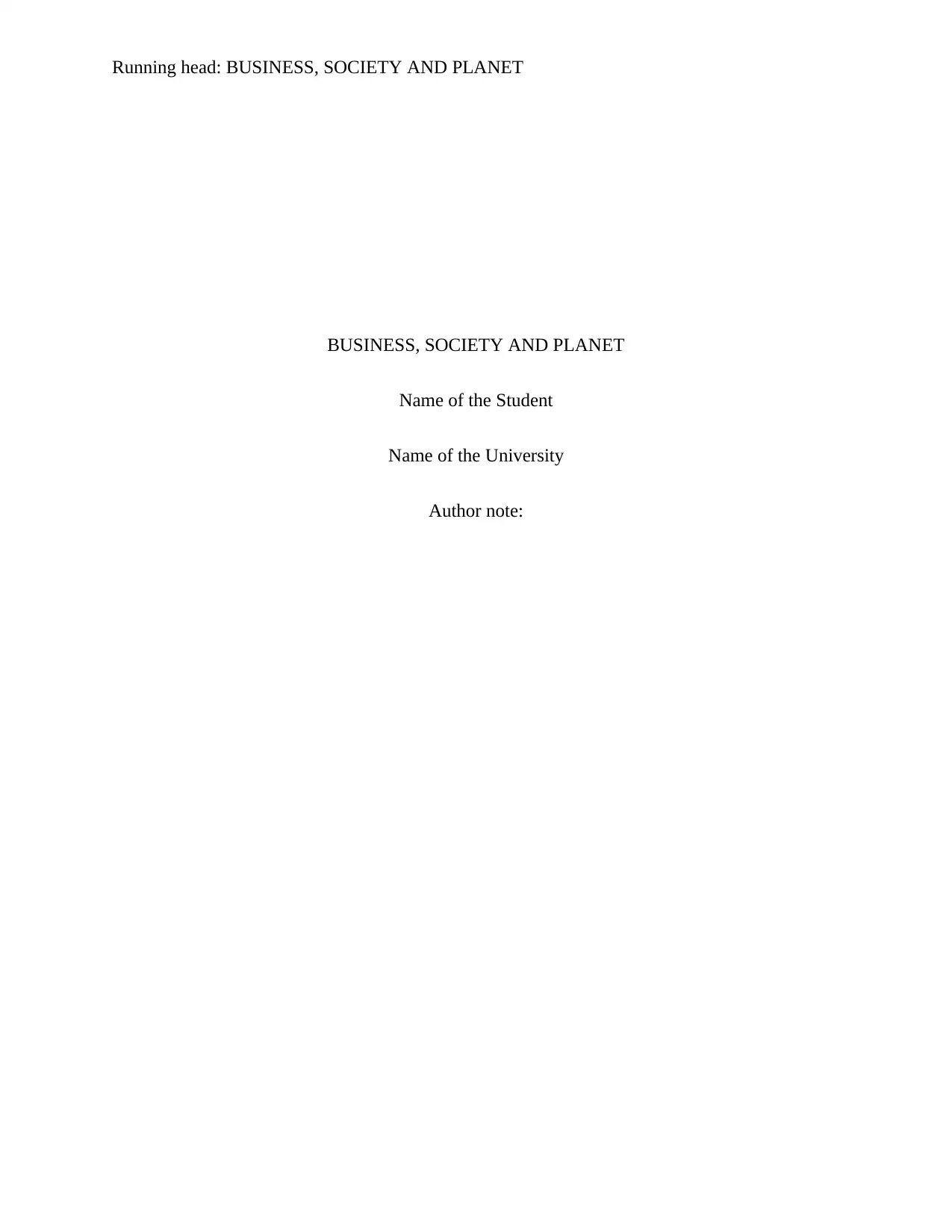
Running head: BUSINESS, SOCIETY AND PLANET
BUSINESS, SOCIETY AND PLANET
Name of the Student
Name of the University
Author note:
BUSINESS, SOCIETY AND PLANET
Name of the Student
Name of the University
Author note:
Paraphrase This Document
Need a fresh take? Get an instant paraphrase of this document with our AI Paraphraser
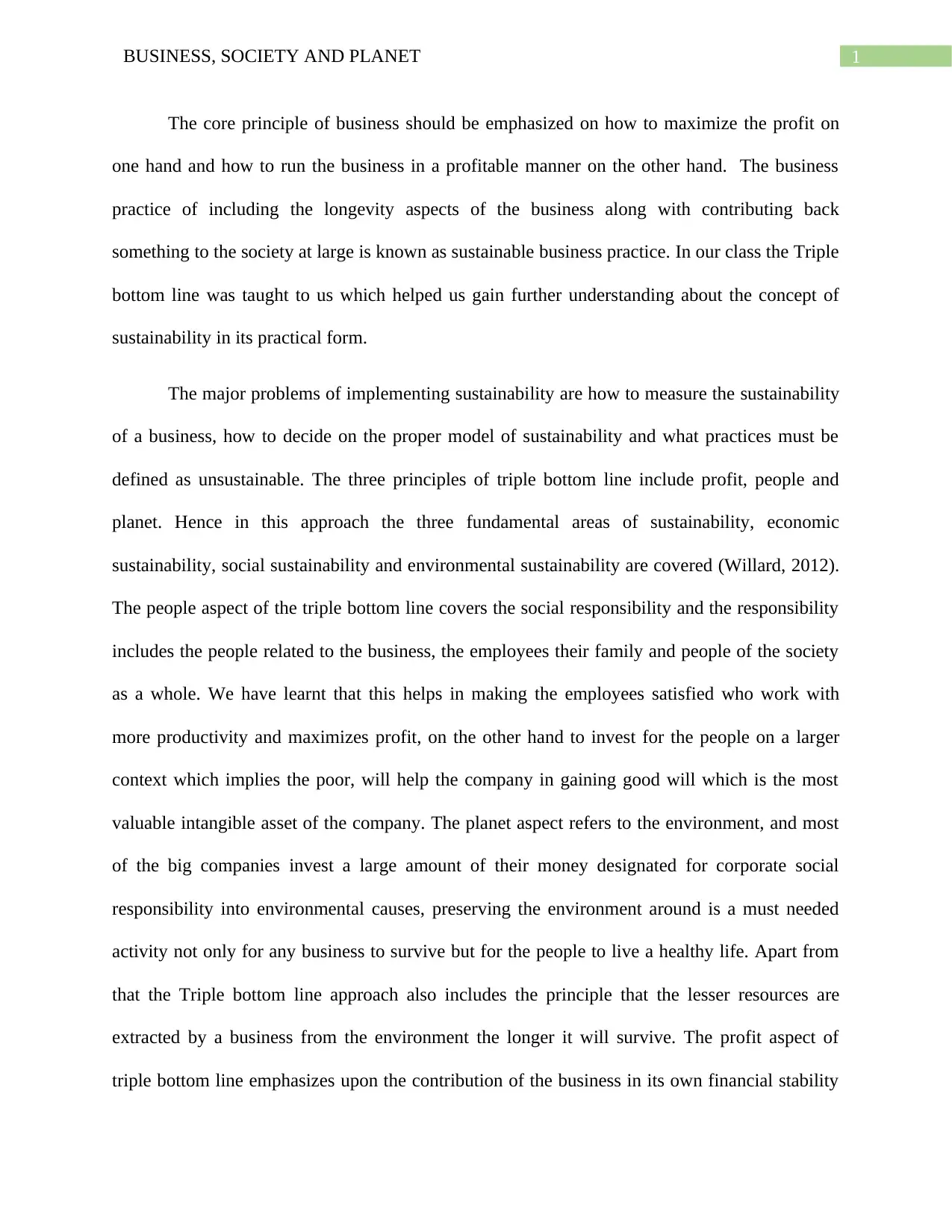
1BUSINESS, SOCIETY AND PLANET
The core principle of business should be emphasized on how to maximize the profit on
one hand and how to run the business in a profitable manner on the other hand. The business
practice of including the longevity aspects of the business along with contributing back
something to the society at large is known as sustainable business practice. In our class the Triple
bottom line was taught to us which helped us gain further understanding about the concept of
sustainability in its practical form.
The major problems of implementing sustainability are how to measure the sustainability
of a business, how to decide on the proper model of sustainability and what practices must be
defined as unsustainable. The three principles of triple bottom line include profit, people and
planet. Hence in this approach the three fundamental areas of sustainability, economic
sustainability, social sustainability and environmental sustainability are covered (Willard, 2012).
The people aspect of the triple bottom line covers the social responsibility and the responsibility
includes the people related to the business, the employees their family and people of the society
as a whole. We have learnt that this helps in making the employees satisfied who work with
more productivity and maximizes profit, on the other hand to invest for the people on a larger
context which implies the poor, will help the company in gaining good will which is the most
valuable intangible asset of the company. The planet aspect refers to the environment, and most
of the big companies invest a large amount of their money designated for corporate social
responsibility into environmental causes, preserving the environment around is a must needed
activity not only for any business to survive but for the people to live a healthy life. Apart from
that the Triple bottom line approach also includes the principle that the lesser resources are
extracted by a business from the environment the longer it will survive. The profit aspect of
triple bottom line emphasizes upon the contribution of the business in its own financial stability
The core principle of business should be emphasized on how to maximize the profit on
one hand and how to run the business in a profitable manner on the other hand. The business
practice of including the longevity aspects of the business along with contributing back
something to the society at large is known as sustainable business practice. In our class the Triple
bottom line was taught to us which helped us gain further understanding about the concept of
sustainability in its practical form.
The major problems of implementing sustainability are how to measure the sustainability
of a business, how to decide on the proper model of sustainability and what practices must be
defined as unsustainable. The three principles of triple bottom line include profit, people and
planet. Hence in this approach the three fundamental areas of sustainability, economic
sustainability, social sustainability and environmental sustainability are covered (Willard, 2012).
The people aspect of the triple bottom line covers the social responsibility and the responsibility
includes the people related to the business, the employees their family and people of the society
as a whole. We have learnt that this helps in making the employees satisfied who work with
more productivity and maximizes profit, on the other hand to invest for the people on a larger
context which implies the poor, will help the company in gaining good will which is the most
valuable intangible asset of the company. The planet aspect refers to the environment, and most
of the big companies invest a large amount of their money designated for corporate social
responsibility into environmental causes, preserving the environment around is a must needed
activity not only for any business to survive but for the people to live a healthy life. Apart from
that the Triple bottom line approach also includes the principle that the lesser resources are
extracted by a business from the environment the longer it will survive. The profit aspect of
triple bottom line emphasizes upon the contribution of the business in its own financial stability
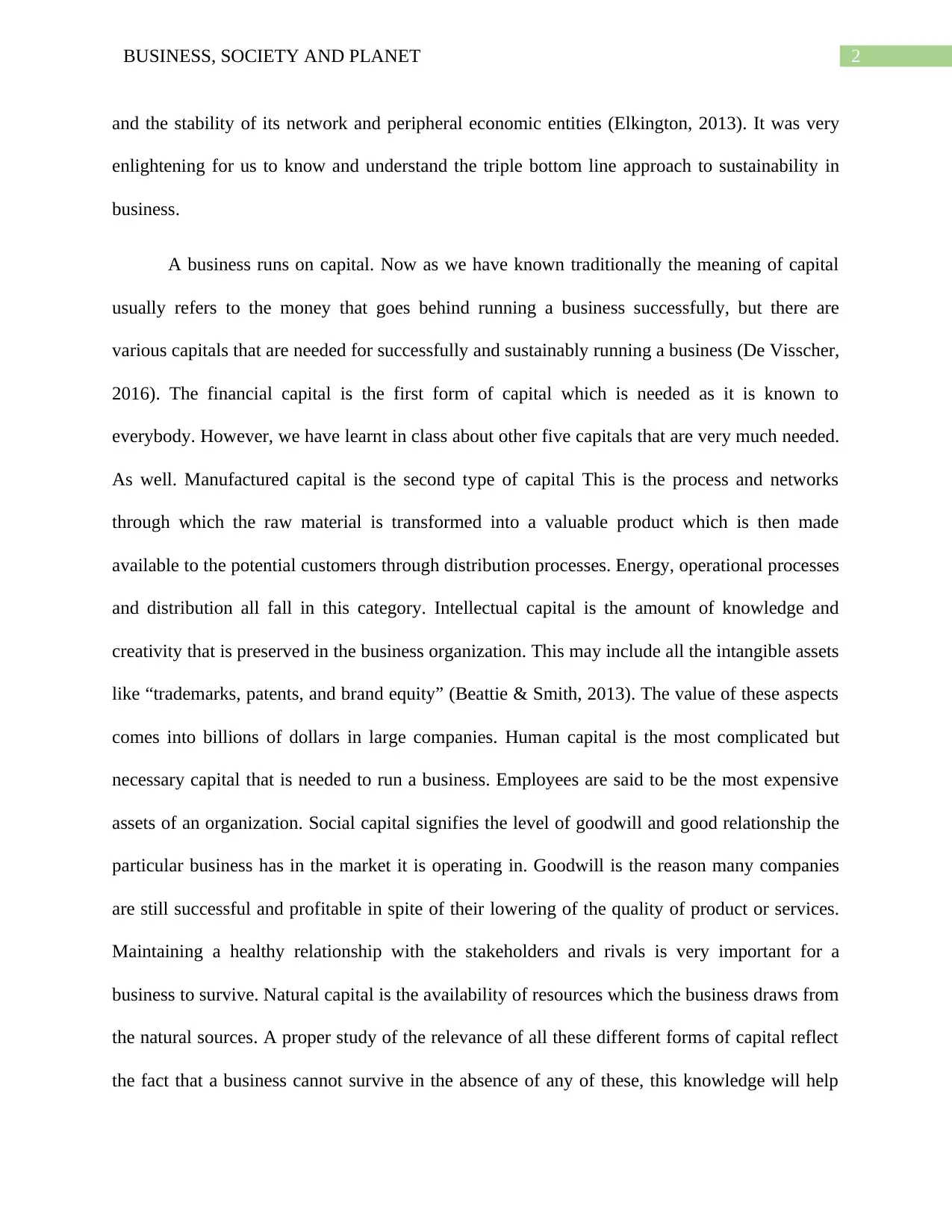
2BUSINESS, SOCIETY AND PLANET
and the stability of its network and peripheral economic entities (Elkington, 2013). It was very
enlightening for us to know and understand the triple bottom line approach to sustainability in
business.
A business runs on capital. Now as we have known traditionally the meaning of capital
usually refers to the money that goes behind running a business successfully, but there are
various capitals that are needed for successfully and sustainably running a business (De Visscher,
2016). The financial capital is the first form of capital which is needed as it is known to
everybody. However, we have learnt in class about other five capitals that are very much needed.
As well. Manufactured capital is the second type of capital This is the process and networks
through which the raw material is transformed into a valuable product which is then made
available to the potential customers through distribution processes. Energy, operational processes
and distribution all fall in this category. Intellectual capital is the amount of knowledge and
creativity that is preserved in the business organization. This may include all the intangible assets
like “trademarks, patents, and brand equity” (Beattie & Smith, 2013). The value of these aspects
comes into billions of dollars in large companies. Human capital is the most complicated but
necessary capital that is needed to run a business. Employees are said to be the most expensive
assets of an organization. Social capital signifies the level of goodwill and good relationship the
particular business has in the market it is operating in. Goodwill is the reason many companies
are still successful and profitable in spite of their lowering of the quality of product or services.
Maintaining a healthy relationship with the stakeholders and rivals is very important for a
business to survive. Natural capital is the availability of resources which the business draws from
the natural sources. A proper study of the relevance of all these different forms of capital reflect
the fact that a business cannot survive in the absence of any of these, this knowledge will help
and the stability of its network and peripheral economic entities (Elkington, 2013). It was very
enlightening for us to know and understand the triple bottom line approach to sustainability in
business.
A business runs on capital. Now as we have known traditionally the meaning of capital
usually refers to the money that goes behind running a business successfully, but there are
various capitals that are needed for successfully and sustainably running a business (De Visscher,
2016). The financial capital is the first form of capital which is needed as it is known to
everybody. However, we have learnt in class about other five capitals that are very much needed.
As well. Manufactured capital is the second type of capital This is the process and networks
through which the raw material is transformed into a valuable product which is then made
available to the potential customers through distribution processes. Energy, operational processes
and distribution all fall in this category. Intellectual capital is the amount of knowledge and
creativity that is preserved in the business organization. This may include all the intangible assets
like “trademarks, patents, and brand equity” (Beattie & Smith, 2013). The value of these aspects
comes into billions of dollars in large companies. Human capital is the most complicated but
necessary capital that is needed to run a business. Employees are said to be the most expensive
assets of an organization. Social capital signifies the level of goodwill and good relationship the
particular business has in the market it is operating in. Goodwill is the reason many companies
are still successful and profitable in spite of their lowering of the quality of product or services.
Maintaining a healthy relationship with the stakeholders and rivals is very important for a
business to survive. Natural capital is the availability of resources which the business draws from
the natural sources. A proper study of the relevance of all these different forms of capital reflect
the fact that a business cannot survive in the absence of any of these, this knowledge will help
⊘ This is a preview!⊘
Do you want full access?
Subscribe today to unlock all pages.

Trusted by 1+ million students worldwide
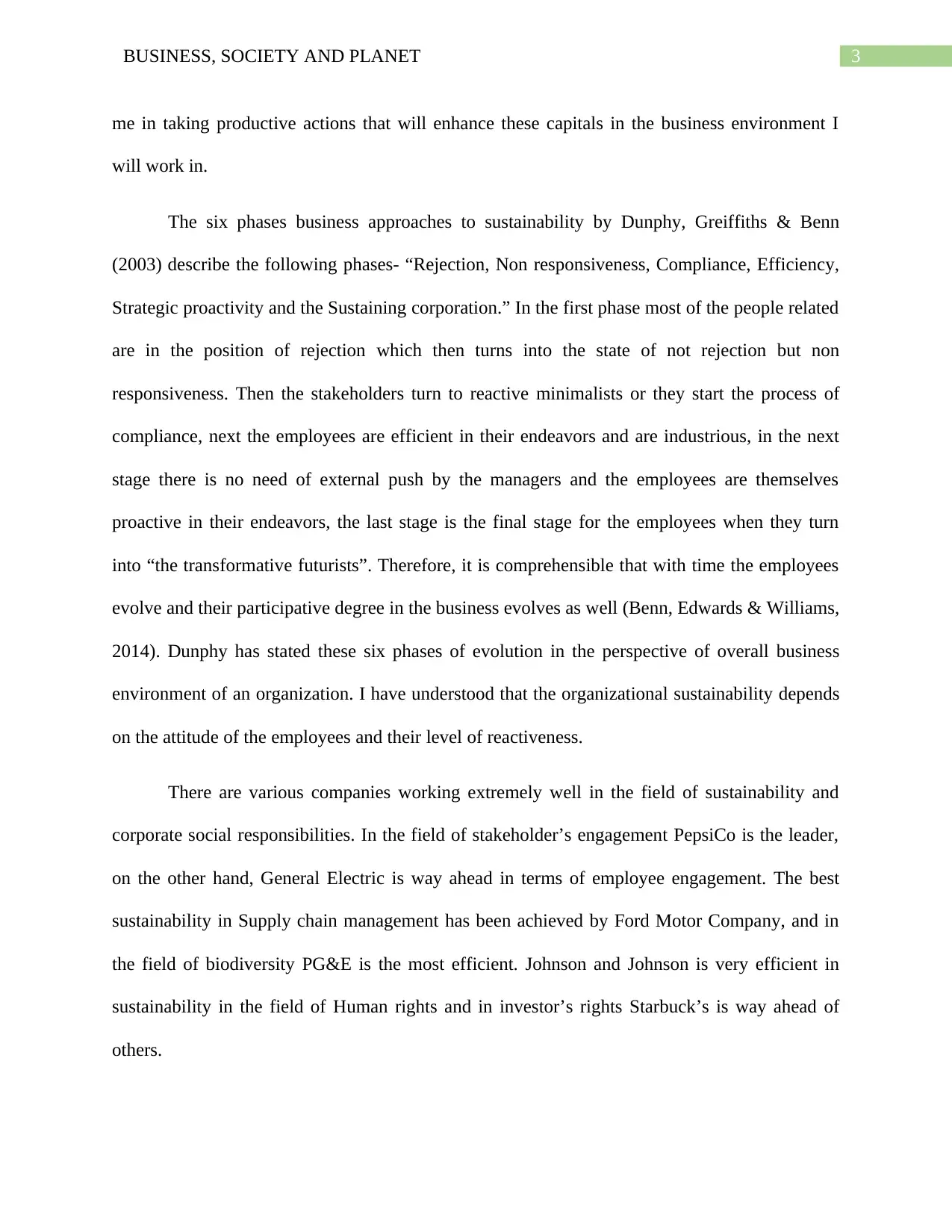
3BUSINESS, SOCIETY AND PLANET
me in taking productive actions that will enhance these capitals in the business environment I
will work in.
The six phases business approaches to sustainability by Dunphy, Greiffiths & Benn
(2003) describe the following phases- “Rejection, Non responsiveness, Compliance, Efficiency,
Strategic proactivity and the Sustaining corporation.” In the first phase most of the people related
are in the position of rejection which then turns into the state of not rejection but non
responsiveness. Then the stakeholders turn to reactive minimalists or they start the process of
compliance, next the employees are efficient in their endeavors and are industrious, in the next
stage there is no need of external push by the managers and the employees are themselves
proactive in their endeavors, the last stage is the final stage for the employees when they turn
into “the transformative futurists”. Therefore, it is comprehensible that with time the employees
evolve and their participative degree in the business evolves as well (Benn, Edwards & Williams,
2014). Dunphy has stated these six phases of evolution in the perspective of overall business
environment of an organization. I have understood that the organizational sustainability depends
on the attitude of the employees and their level of reactiveness.
There are various companies working extremely well in the field of sustainability and
corporate social responsibilities. In the field of stakeholder’s engagement PepsiCo is the leader,
on the other hand, General Electric is way ahead in terms of employee engagement. The best
sustainability in Supply chain management has been achieved by Ford Motor Company, and in
the field of biodiversity PG&E is the most efficient. Johnson and Johnson is very efficient in
sustainability in the field of Human rights and in investor’s rights Starbuck’s is way ahead of
others.
me in taking productive actions that will enhance these capitals in the business environment I
will work in.
The six phases business approaches to sustainability by Dunphy, Greiffiths & Benn
(2003) describe the following phases- “Rejection, Non responsiveness, Compliance, Efficiency,
Strategic proactivity and the Sustaining corporation.” In the first phase most of the people related
are in the position of rejection which then turns into the state of not rejection but non
responsiveness. Then the stakeholders turn to reactive minimalists or they start the process of
compliance, next the employees are efficient in their endeavors and are industrious, in the next
stage there is no need of external push by the managers and the employees are themselves
proactive in their endeavors, the last stage is the final stage for the employees when they turn
into “the transformative futurists”. Therefore, it is comprehensible that with time the employees
evolve and their participative degree in the business evolves as well (Benn, Edwards & Williams,
2014). Dunphy has stated these six phases of evolution in the perspective of overall business
environment of an organization. I have understood that the organizational sustainability depends
on the attitude of the employees and their level of reactiveness.
There are various companies working extremely well in the field of sustainability and
corporate social responsibilities. In the field of stakeholder’s engagement PepsiCo is the leader,
on the other hand, General Electric is way ahead in terms of employee engagement. The best
sustainability in Supply chain management has been achieved by Ford Motor Company, and in
the field of biodiversity PG&E is the most efficient. Johnson and Johnson is very efficient in
sustainability in the field of Human rights and in investor’s rights Starbuck’s is way ahead of
others.
Paraphrase This Document
Need a fresh take? Get an instant paraphrase of this document with our AI Paraphraser
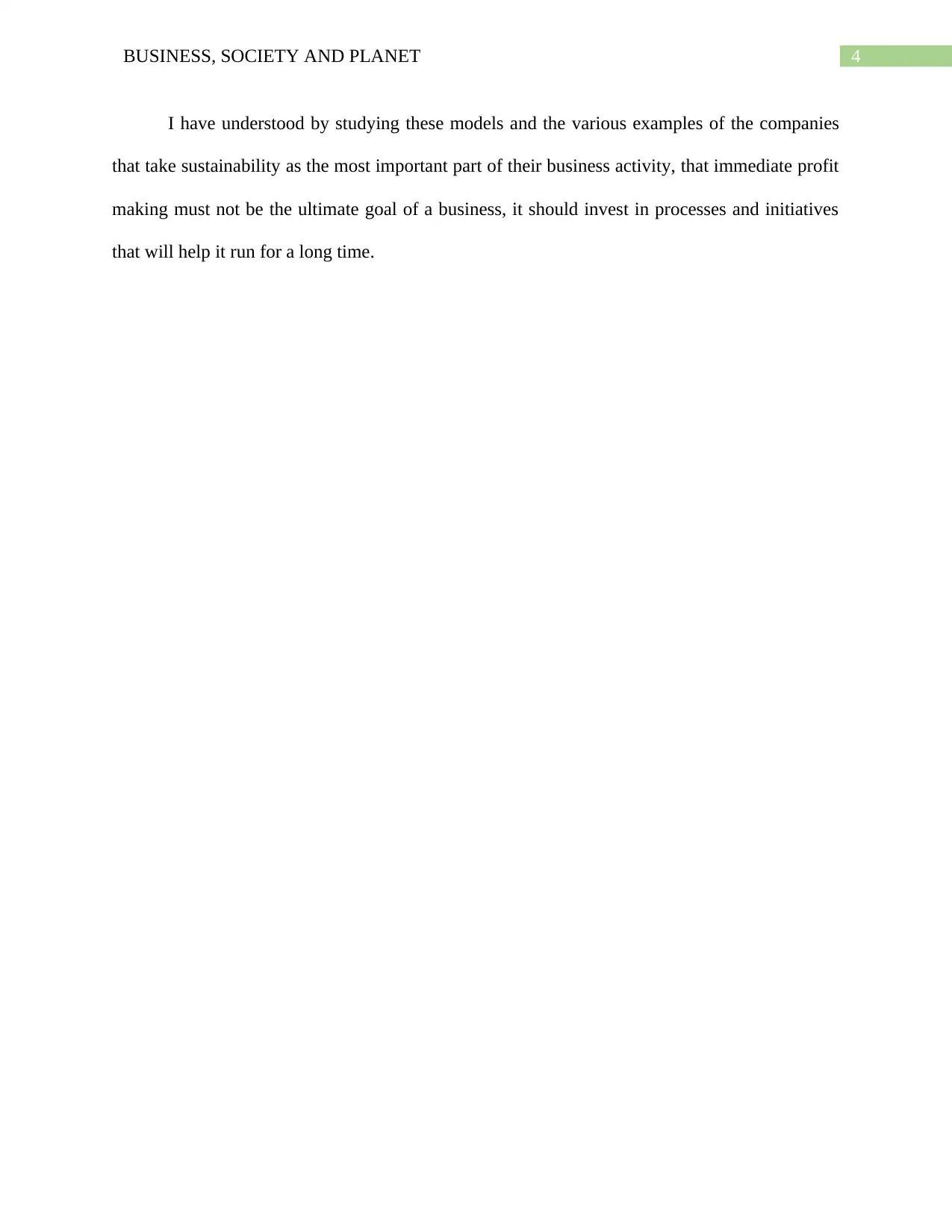
4BUSINESS, SOCIETY AND PLANET
I have understood by studying these models and the various examples of the companies
that take sustainability as the most important part of their business activity, that immediate profit
making must not be the ultimate goal of a business, it should invest in processes and initiatives
that will help it run for a long time.
I have understood by studying these models and the various examples of the companies
that take sustainability as the most important part of their business activity, that immediate profit
making must not be the ultimate goal of a business, it should invest in processes and initiatives
that will help it run for a long time.
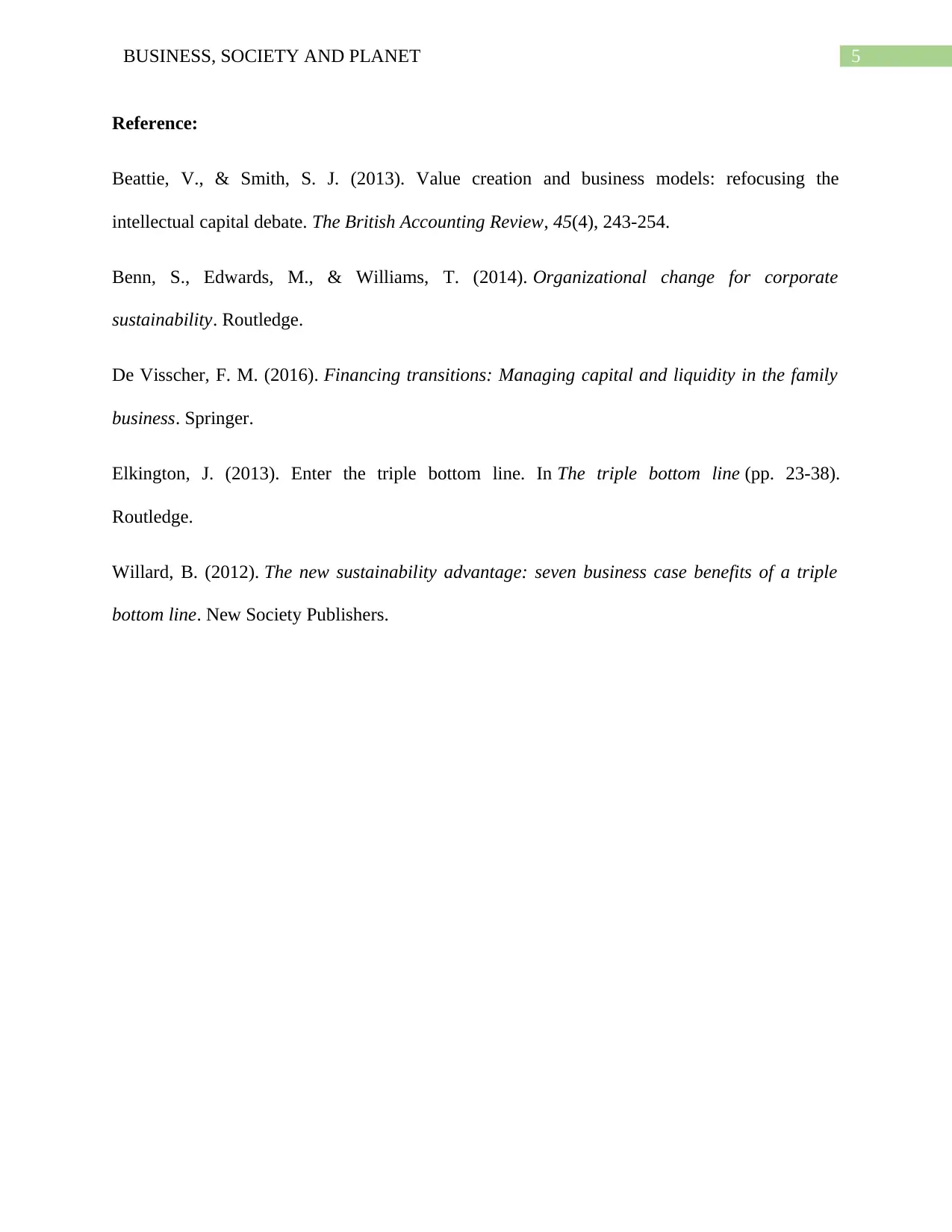
5BUSINESS, SOCIETY AND PLANET
Reference:
Beattie, V., & Smith, S. J. (2013). Value creation and business models: refocusing the
intellectual capital debate. The British Accounting Review, 45(4), 243-254.
Benn, S., Edwards, M., & Williams, T. (2014). Organizational change for corporate
sustainability. Routledge.
De Visscher, F. M. (2016). Financing transitions: Managing capital and liquidity in the family
business. Springer.
Elkington, J. (2013). Enter the triple bottom line. In The triple bottom line (pp. 23-38).
Routledge.
Willard, B. (2012). The new sustainability advantage: seven business case benefits of a triple
bottom line. New Society Publishers.
Reference:
Beattie, V., & Smith, S. J. (2013). Value creation and business models: refocusing the
intellectual capital debate. The British Accounting Review, 45(4), 243-254.
Benn, S., Edwards, M., & Williams, T. (2014). Organizational change for corporate
sustainability. Routledge.
De Visscher, F. M. (2016). Financing transitions: Managing capital and liquidity in the family
business. Springer.
Elkington, J. (2013). Enter the triple bottom line. In The triple bottom line (pp. 23-38).
Routledge.
Willard, B. (2012). The new sustainability advantage: seven business case benefits of a triple
bottom line. New Society Publishers.
⊘ This is a preview!⊘
Do you want full access?
Subscribe today to unlock all pages.

Trusted by 1+ million students worldwide
1 out of 6
Related Documents
Your All-in-One AI-Powered Toolkit for Academic Success.
+13062052269
info@desklib.com
Available 24*7 on WhatsApp / Email
![[object Object]](/_next/static/media/star-bottom.7253800d.svg)
Unlock your academic potential
Copyright © 2020–2025 A2Z Services. All Rights Reserved. Developed and managed by ZUCOL.




